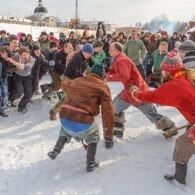Slavic-Goritsky wrestling (SGB) is a national martial art revived by A. Belov. The SGB unites the most diverse traditions of Russian competitive culture, and although it did not exist as a system before, its components – notch, stenoshny, hunting combat and Vlesov wrestling – are real elements of the competitive tradition.
Slavyano-goritsa has absorbed all those grains of ancient Russian warfare that enthusiasts of the revival of the national competitive culture managed to collect in numerous ethnographic expeditions.
In the West, the SGB is known as gorits fighting.
Types of combat in the State Security Service
Classic combat is a complex of organized combat actions aimed at prolonged stand-up combat. It has a special task – to achieve victory over the enemy through the use of tactical art and combinational superiority. Classic combat is most applicable in fights with representatives of other types of martial arts, when prone wrestling is limited or prohibited.
Assault combat is a complex of organized attack actions, the task of which is the active offensive suppression of any form of enemy resistance, regardless of his physical characteristics and the degree of combat training. It has a special technical and ethical-philosophical development. Based on the study and management of human behavior patterns and the standards of the mechanics of his actions. Assault combat is most applicable in a street fight, as well as in situations that require making the only correct decisions.
Street Assault is based on a rapid assessment of the enemy’s combat behavior and the use of this assessment to select the most accurate form of attack. It sounds concise, but the whole procedure is performed reflexively, in the amount of one second. This variant of Sturm can be considered a reaction to enemy behavior.
Sports Assault has a lot of conventions that are unique to this genre. It obliges the competitors to attack throughout the entire duration of the fight, otherwise the actions of the parties can hardly be called an assault. The mutual attack usually looks like a brutal mutual beating at a “jammed” distance. This is the difficulty of sport. You cannot leave the distance for the purpose of defense; according to the rules, this means refusing to fight. The winner is the one who is able to break into the clinch, knock the opponent to the ground and, without losing initiative, complete the attack on the ground. The legs are the first to enter the battle, this is also a prerequisite.
Sports Assault scheme:
- from a long distance – kicks;
- at medium distance – serial punches;
- after approaching – knocking down to the ground;
- non-stop continuation of the attack on the ground.
For everything about everything – 10 seconds, this period of time is called “gathering”. There are 10 fights in total in one sports battle. According to the rules, the pause time between them should not exceed the time of the descent itself (i.e. 10 seconds).
Total fight is a complex of specially organized technical actions for a professional fight in a fight without rules. A feature of Total Combat is special technical training focused on combat with fighters of jiu-jitsu, judo, sambo, freestyle wrestling, boxing, kickboxing and karate, as well as the Russian stylistic organization of the techniques of this fight. Total combat is most applicable for fights with representatives of other types of martial arts according to rules that have no restrictions on prone wrestling.
Military-applied combat is a specialized army complex that meets the goals and objectives of training a warrior to conduct combat operations at short firing distances and in conditions of hand-to-hand contact with the enemy. Includes: fire training according to a non-traditional program; swimming training in a special way; special techniques for moving and controlling space; the art of survival in conditions of prolonged isolation and extreme situations; universal skills in using edged weapons.
Basic styles
RADOGORA is a hand-fighting style that incorporates the technical and tactical developments of schools: Slavic-Goritsky wrestling, Soviet boxing and Russian ethnographic styles.
HELM – a style of fighting with legs, where the hands perform only protective functions. Methods of movement and strikes are borrowed from martial dances, from historical schools of Russian hand-to-hand combat.
ROCKER (proportional style) – a combat system in which a high tempo of movements is achieved by alternating strikes of the hands and feet due to inertia and plasticity, which saves effort.
ROCKER (proportional style) – a combat system in which a high tempo of movements is achieved by alternating strikes of the hands and feet due to inertia and plasticity, which saves effort.
POSITION (complex fight on the ground) – a style in which creases, coups, holds, painful and suffocating actions, and any prone strikes are used.
SVILYA (combat gymnastics) is a system of actions that allows you to evade enemy strikes and grabs. Forms a fighter’s special plasticity of movements: allows him to avoid an attack without excessive effort.
Application styles
PYATA (style of unplanned situations) – develops combat skills in the dark and cramped conditions, on slippery surfaces and with numerical superiority of opponents.
CHEST – a way of organizing a fight with an opponent who is physically superior (in height, weight and strength).
FLEXIBLE REBUILDINGS (countersystem) – maneuvering and tactical tricks taking into account the stereotypical actions of the enemy using one or another type of martial arts.
“S-42” – Slavic-Goritsky wrestling, adapted for use in real combat conditions. Includes the most effective technical actions, a survival system and special skills.
FIRE COMBAT – a fight using firearms. The system is based on: a) pistol triathlon: counter combat (duel shooting in motion), aimed shooting, demonstration of combat movement techniques; b) general principles of combat with a machine gun.
BLADE COMBAT – a combat system based on knife triathlon (free combat, knife throwing and demonstration of military equipment while moving).





